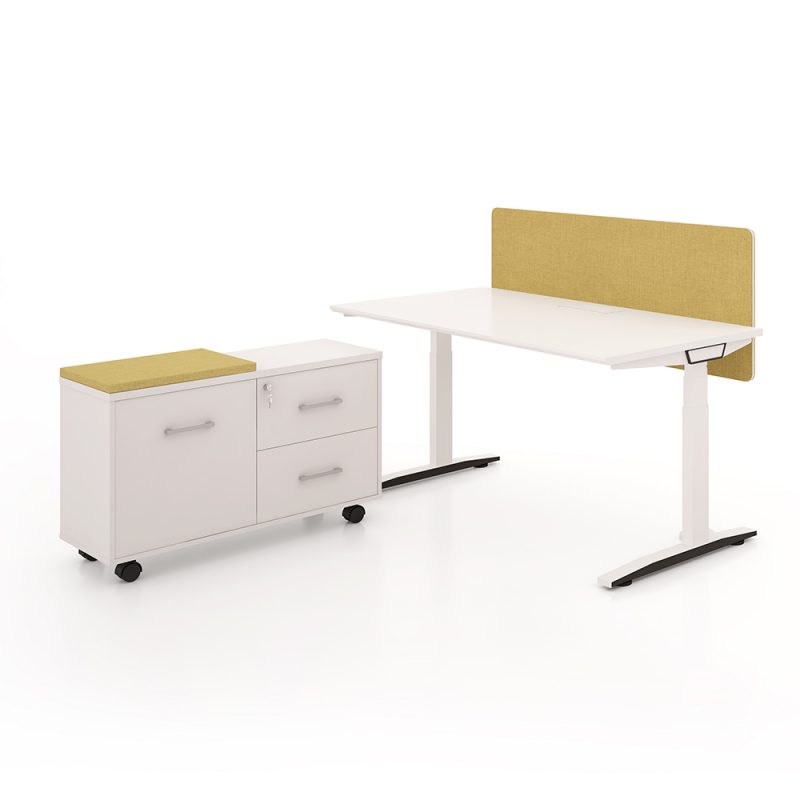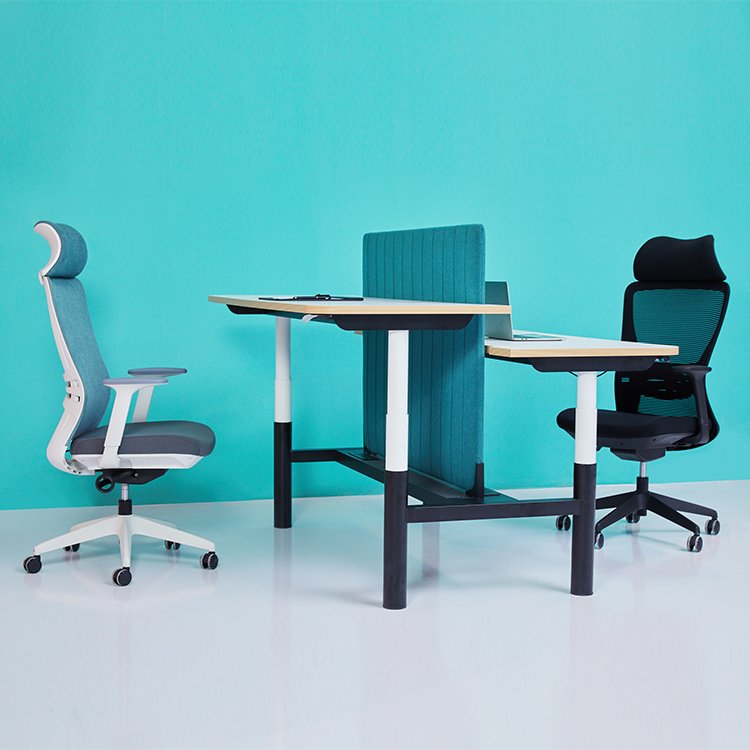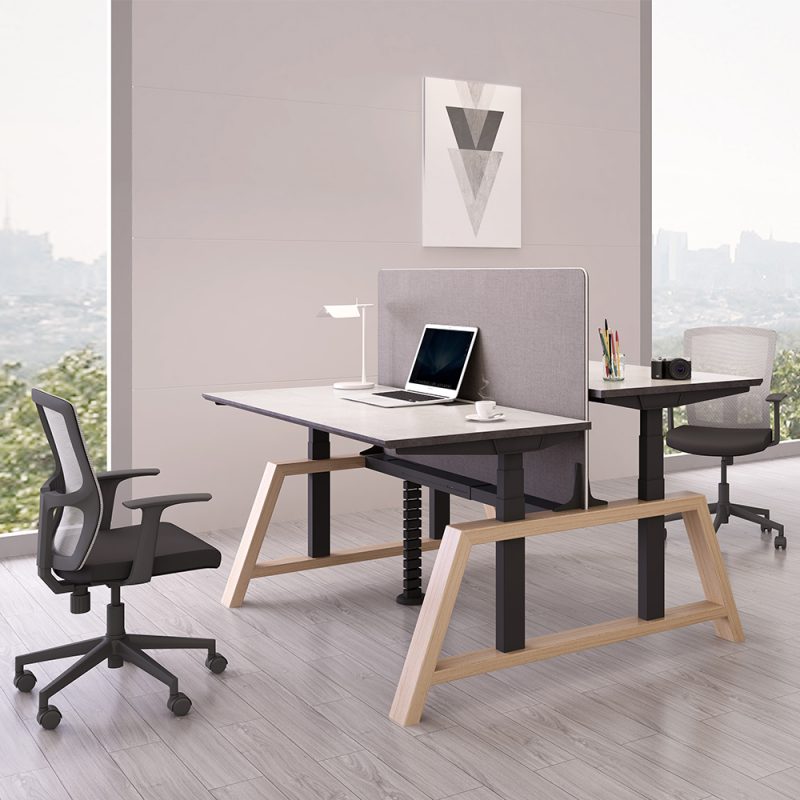The reality is, sitting all day isn’t doing our bodies any favors. Between long hours at the desk, meetings, and endless Zoom calls, many of us are glued to our chairs without even realizing how much it’s affecting our bodies. Back pain, neck strain, tiredness—sound familiar?
That’s where standing desks come in. They’re not just a trendy office gadget; they could be a game-changer for your health and productivity. Whether you work from home or in an office, switching things up by standing more throughout your day can make a huge difference.
In this post, we’re diving into various standing desk benefits, useful tips to help you get started, along with our top picks for the best standing desks.
Table of Contents
- Top 6 Incredible Standing Desk Benefits
- 5 Best Standing Desks for Work and Gaming
- How to Get Started with a Standing Desk
- FAQs
- Final Thoughts on Standing Desk Benefits
Top 6 Incredible Standing Desk Benefits
First thing first, what is a standing desk? A standing desk is just what it appears to be—a desk that lets you switch between sitting and standing while you work. They’re adjustable, so you can raise or lower your desk to a comfortable height, whether standing or sitting.
Some desks are manual, meaning you adjust them by hand, while others are electric and do the work for you with the push of a button. There are also smaller desk converters that sit on top of your regular desk, turning it into a standing desk when you need it.
The benefits of using an adjustable standing desk are diverse. Let’s take a look at how it can improve your health, boost your productivity, and make your workday a lot more comfortable.
1. Less Back Pain and Neck Pain
Sitting for extended periods is one of the culprits behind back and neck pain, especially if you’re hunched over a desk or using a poor-quality office chair. A bad chair that doesn’t provide proper support can make things worse by forcing you to slouch or sit in awkward positions.
When you stand, your spine is more naturally aligned, and your muscles aren’t working as hard to keep you upright. Shifting between sitting and standing gives your body a break, which can help reduce discomfort over time.
In fact, a study published by the CDC found that using an adjustable standing desk relieved upper back pain and neck strain by 54% after just four weeks. That’s a big improvement, and it shows just how much a simple change in your work routine can help.
2. Better Posture
Standing up helps you keep a better posture. As mentioned before, when you’re standing, your spine naturally stays in alignment, and your shoulders are less likely to slouch. This is a huge win for your back and neck, especially after hours of sitting.
Plus, standing distributes the pressure on your body more evenly, so you don’t put all the strain on your lower back or hips.
And here’s the best part: standing makes it easier to move. Take a coffee break, stretch your legs, or walk around for a bit. These simple actions can help relieve stiffness and keep you feeling comfortable throughout the day.
3. Lower Risk of Chronic Conditions
Prolonged sitting is linked to various health problems, including heart disease, obesity, and diabetes. When we sit for hours, our muscles aren’t active, which slows down our metabolism and reduces calorie burn. This immobility can lead to weight gain and contribute to poor blood circulation.
Standing more often can help counteract these risks. It keeps your blood flowing, which helps maintain healthy circulation. When you’re standing, your muscles are engaged, promoting better blood flow and preventing the stiffness and sluggishness that come with sitting. Some studies have even shown that standing more can lower the risk of heart disease.
It’s a simple shift—standing more often and moving throughout the day can significantly impact your long-term health. Small changes like this add up over time, helping you be more active and healthy, even during a desk job.
4. More Energy and Less Fatigue
Ever feel like you’re dragging by the afternoon? Sitting all day can take its toll on your energy levels. When you’re stuck in a chair, blood flow slows down, and it’s easy to feel sluggish and tired. But standing up gives your body a little boost. It helps get the blood flowing, which can keep you feeling more alert and energized throughout the day.
In a 7-week study, people who used standing desks reported feeling less stressed and tired than those who stayed seated all day. Getting on your feet more often can help you shake off that midday slump and stay sharp for longer.
5. Flexibility for Shared Workspaces
We’ve talked about the health and productivity benefits of standing desks, but there’s another advantage worth mentioning—how flexible they are, especially in shared or open workspaces.
Standing desks allow you to adjust your workspace to fit your needs, whether you want to stand for a bit, sit, or switch between the two throughout the day.
In open offices, where desk space can sometimes feel limited or shared, standing desks are perfect for mixing things up. They allow people to collaborate more easily without being stuck in the same position all day.
Plus, they make it easier for everyone to stay mobile and move around—whether you’re grabbing a coffee with a coworker or just needing a change of scenery.
6. Customizable Settings for Better Ergonomics
One of the best things about standing desks is how customizable they are. You can easily adjust your sit-stand desk to the right height for your body, whether you’re sitting, standing, or switching between the two. This is essential for maintaining good posture and lessening strain on your neck, back, and wrists. When your desk is at the right height, it’s much easier to avoid discomfort.
Many standing desks come with memory presets, allowing you to save your favorite positions. This feature is handy if you like to switch between sitting in your office chair, using a saddle chair, or going full standing. Just press a button, and your desk will adjust to your preferred settings. You can work in a way that feels most comfortable and natural throughout the day.
5 Best Standing Desks for Work and Gaming
If you’re ready to invest in a standing desk, you’ll want one that suits your needs and space. Here are some of our top picks that offer great features, durability, and value for money.
1. Meet&Co Office Furniture Sendi Standing Desk
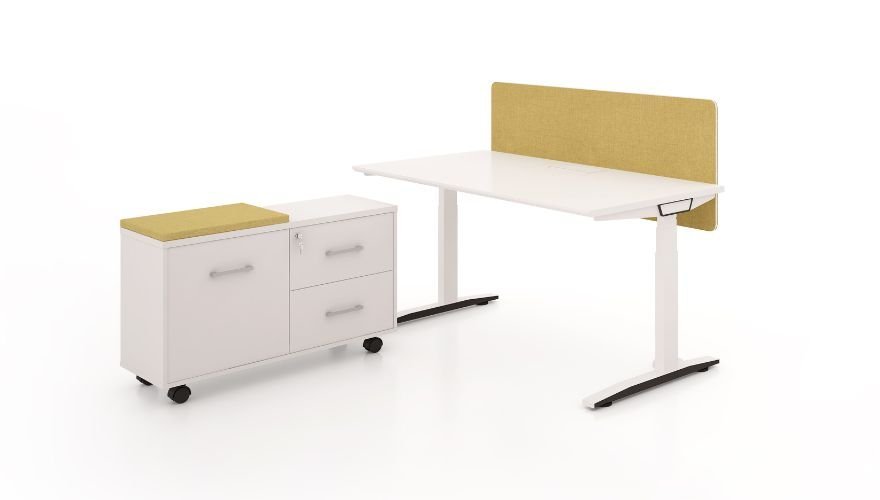
Key Specifications:
Desk Size: 47.2″ W x 23.6″ D; 55.1″ W x 23.6″ D; 55.1″ W x 27.6″ D; 63.0″ W x 27.6″ D; 70.9″ W x 27.6″ D; customizable
Height Range: 24.0″ – 49.6″
Memory: 4 presets
Shape: Standard; L-shaped; face-to-face two-person workstation
Colors: Customizable
Materials: E1 MFC and steel
Assembly: Require assembly
Warranty: 1 – 3 years
The Sendi Standing Desk from Meet&Co Office Furniture is a budget-friendly yet quality standing desk that doesn’t cut corners.
You can customize it in several ways—choose your size, color, and finish to match your workspace. It even offers L-shaped options and can be set up for a single user or a face-to-face two-person workstation, making it ideal for various office layouts.
It checks all the basics with smooth height adjustments, easy setup, and preset memory options. Whether you’re outfitting a home office or placing bulk orders for a professional workspace, the Sendi offers excellent value without compromising on functionality.
2. Uplift V2 Standing Desk

Key Specifications:
Desk Size: 42″ W x 30″ D; 48″ W x 30″ D; 60″ W x 30″ D; 72″ W x 30″ D; 80″ W x 30″ D
Height Range: 24.3″ – 49.9″
Weight Capacity: 355 lbs
Memory: 4 presets (for advanced keypads)
Speed: 2 inches/sec
Noise: < 48 db
Colors: 4 frame colors; 31 colors for the desktop
Materials: Laminate, bamboo, solid wood, and more
Assembly: Require assembly
Warranty: 15 years
The Uplift V2 is one of the most popular and well-reviewed standing desks on the market. It’s all about customization, making it a great pick if you want a desk that fits your needs. You can select various sizes, finishes, and add-ons like cable management systems or even extra storage options.
The motorized height adjustments are smooth, and you can store your preferred sitting and standing heights with its memory presets. Remember, the more features you choose, the higher the price tag will go. But if you’re looking for a desk that you can truly make your own, the Uplift V2 is worth considering.
3. Branch Duo Standing Desk

Key Specifications:
Desk Size: 36” W x 24” D; 48” W x 24” D; 58” W x 27” D
Height Range: 28 – 47.8″
Weight Capacity: 275 lbs
Memory: 2 presets
Speed: 1.3 inches/sec
Noise: < 50 db
Colors: 3 frame colors; 5 colors for the desktop
Materials: MDF and steel
Assembly: Require assembly
Warranty: 10 years
One of the things we love about the Branch Duo Standing Desk is its compact size, making it an excellent choice for small spaces or home offices where every inch counts. Despite its smaller footprint, it still offers plenty of workspace, with a clean, minimalistic design that fits well in any setting.
It has smooth electric motor adjustments for easy switching between sitting and standing positions, and it’s built with high-quality materials for long-lasting durability. Plus, it’s easy to assemble and offers excellent stability, so you don’t have to worry about wobbling. If you’re looking for a sleek and dependable desk that doesn’t take up too much room, the Branch Duo is a solid pick.
4. Secretlab Magnus Pro Gaming Standing Desk

Key Specification:
Desk Size: 59.1″ W x 27.6″ D
Height Range: 25.6″ – 49.2″
Weight Capacity: 265 lbs
Memory: 3 presets
Speed: 30mm/sec
Noise: < 50 db
Colors: Black, white
Materials: MDF, steel, high-pressure laminate bamboo with steel
Assembly: Require assembly
Warranty: 5 years
If you’re into both work and gaming, the Secretlab Magnus Pro is a desk that ticks all the boxes. Its sleek, premium design fits right into any setup, whether you’re working on your laptop or gearing up for a gaming marathon.
We’re impressed by its super efficient cable management system. Pesky cables are a thing of the past with the Secretlab Magnus Pro, thanks to its hidden cable channel that keeps everything neat. It even acts as a power hub, rerouting power from the base to the top so your cords stay untangled when you adjust the desk height.
The adjustable height and sturdy steel frame make it perfect for those long gaming sessions (or workdays), ensuring the desk stays rock-solid. If you’re after a functional and stylish desk, this gaming standing desk is worth checking out.
5. Burrow CoPilot Standing Desk

Key Specification:
Desk Size: 27″ L x 43″ W
Height Range: 28.5″– 48″ H
Weight Capacity: 300 lbs
Memory: 3 presets
Colors: Oak, Walnut
Materials: Solid Beech (hardwood), Engineered wood, Ash Veneer, Powder-coated steel
Assembly: Require assembly
Warranty: 1 year
The Burrow CoPilot Standing Desk is a stylish and practical option, with built-in drawers and a cord organization compartment to keep your workspace neat and clutter-free. It also checks all the basics, offering easy setup, smooth adjustments, and convenient presets for sitting and standing positions.
While it offers excellent storage and a sleek design, it’s available in only one size and a limited selection of colors, so customization is a bit more restricted. Still, if you’re looking for a functional desk that doesn’t sacrifice style, the CoPilot is a great choice.
How to Get Started with a Standing Desk
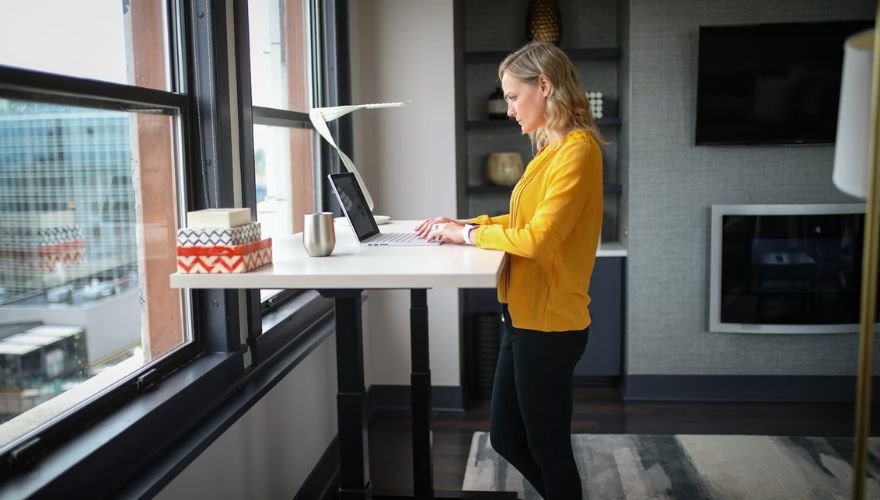
How do you actually start using a standing desk? Don’t worry—it’s easier than it sounds. Here are a few tips to help you make the transition smoothly.
1. Choose the Right Desk
The first step is picking the right standing desk. If you’re going for a full-standing desk, look for one that’s adjustable so you can easily switch between sitting and standing positions. If you’re tight on space, a desk converter that sits on top of your existing desk might be a good option. Either way, make sure it’s stable and easy to adjust.
2. Set Up for Comfort
Once you have your desk, it’s time to make sure everything is in the right place. Your monitor should be at eye level—this helps reduce neck strain. Your mouse and keyboard should be placed at a comfortable height so your arms can stay relaxed. If you’re using a standing desk for long periods, consider getting an anti-fatigue mat to help with comfort.
3. Start Slow
The key to adjusting to a standing desk is to ease into it. You don’t need to stand all day from the get-go. Start by standing for 15–30 minutes at a time, then gradually increase it as your body gets used to the change. You can alternate between different positions throughout the day to find a balance that works best for you.
4. Consider Potential Discomfort
It’s normal to feel some discomfort when starting with a standing desk, but maintaining proper posture while standing can help reduce this. Focus on good posture—shoulders back, knees slightly bent, and weight evenly distributed on both feet.
Use an anti-fatigue mat for extra comfort, and wear supportive shoes. Even if you’re using a standing desk, it’s still a good idea to have an ergonomic office chair on hand for when you need to sit and take a break.
Start slowly and gradually extend your standing time as your body adjusts.
5. Consider Workplace Limitations
Not every workspace is set up for a standing desk, especially if you have limited space. A desk converter might be a good alternative if a full-standing desk feels too much. These desk converters sit on top of your current desk and allow you to adjust your workspace for standing or sitting. This way, you can still enjoy the benefits of standing without needing a big, permanent setup.
6. Mix It Up
Sitting or standing for long periods isn’t great for your body. The key is to mix it up—alternate between sitting, standing, and moving throughout the day. A small change in posture goes a long way in keeping you comfortable, energized, and productive.
FAQs
1. How long should I stand at my desk each day?
While there’s no one-size-fits-all answer, experts recommend aiming for about 15–30 minutes of standing every hour. Gradually increase your standing time as your body gets used to it. Remember, the key is to mix it up!
2. Are standing desks good for people with back pain?
Yes! Standing desks can help reduce back and neck pain by promoting better posture. However, proper ergonomics is important to avoid strain.
3. Do I need an anti-fatigue mat for standing?
While not essential, an anti-fatigue mat can make standing more comfortable by reducing pressure on your feet and legs, particularly during extended periods.
Final Thoughts on Standing Desk Benefits
Are standing desks worth it? For many, the answer is yes.
They can transform your workday, boosting energy and improving posture. Whether you want to be more productive or reduce discomfort, the standing desk benefits are clear, and there are desks to suit every space and budget.
Start slow, find what works for you, and see the difference for yourself. Ready to make the change? Check out our top picks and find the perfect desk for your needs!



